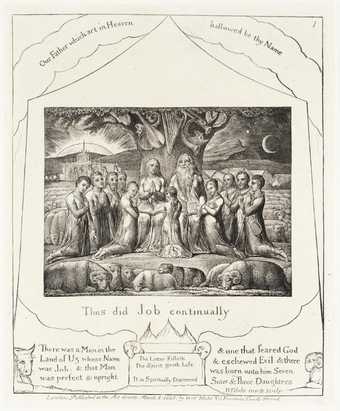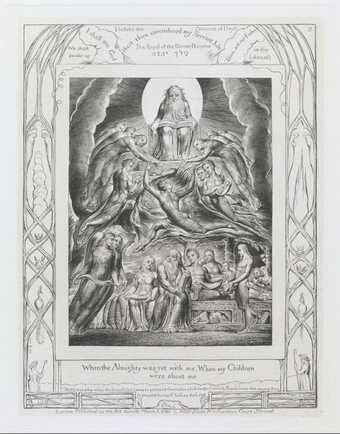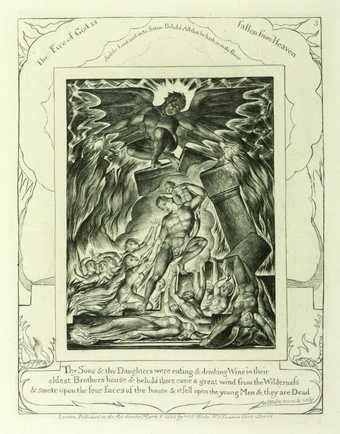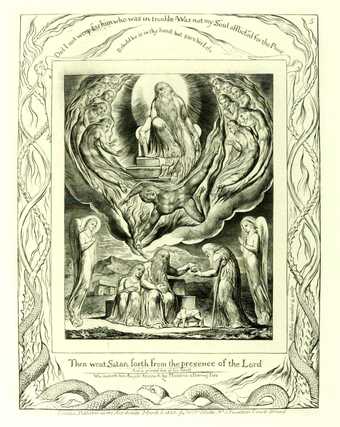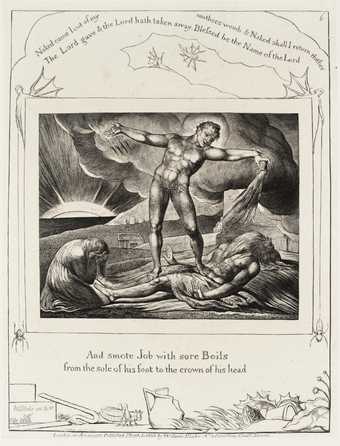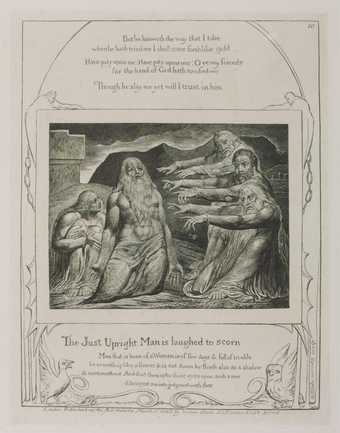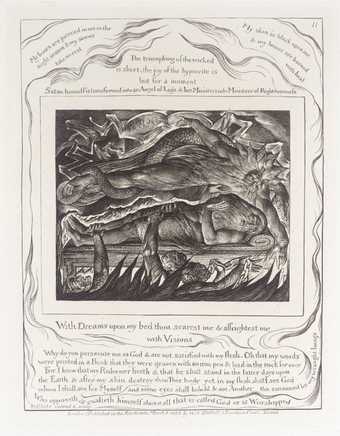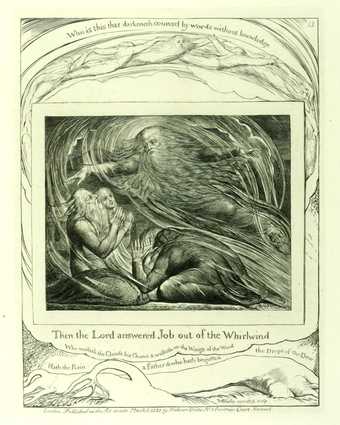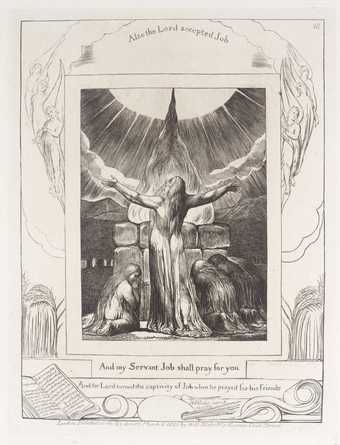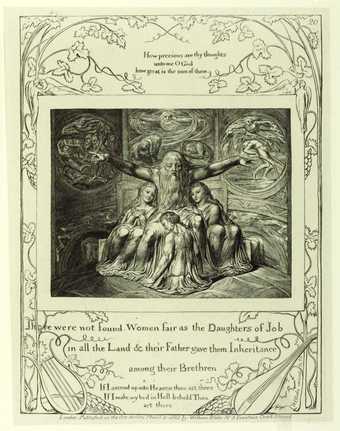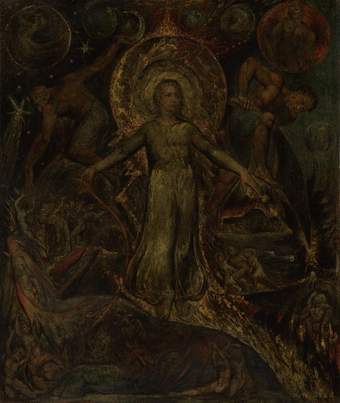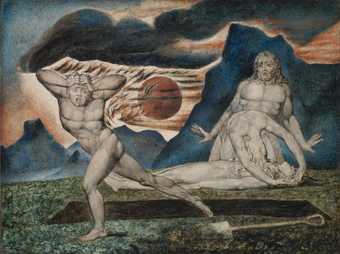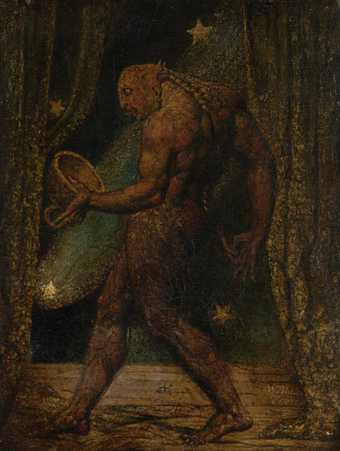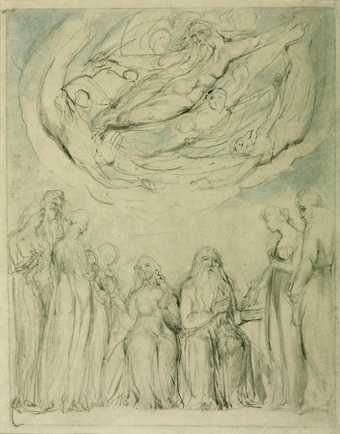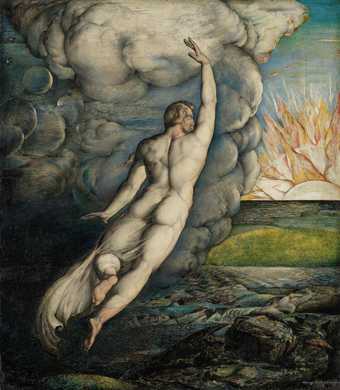
In Tate Britain
- Artist
- William Blake 1757–1827
- Medium
- Ink and tempera on mahogany
- Dimensions
- Support: 326 × 432 mm
frame: 380 × 483 × 37 mm - Collection
- Tate
- Acquisition
- Presented by Miss Mary H. Dodge through the Art Fund 1918
- Reference
- N03340
Display caption
The biblical ‘Book of Job’ addresses the existence of evil and suffering in a world where a loving, all-powerful God exists. It has been described as ‘the most profound and literary work of the entire Old Testament’.
In ‘Job’, God and Satan discuss the limits of human faith and endurance. God lets Satan force Job to undergo extreme trials and tribulations, including the destruction of his family. Despite this, as God predicted, Job’s faith remains unshaken and he is rewarded by God with the restoration of his health, wealth and family. Here Blake shows Satan torturing Job with boils.
From The Holy Bible (King James version), Book of Job, Chapter II, 3-10
3. And the Lord said unto Satan, Hast thou considered my servant Job, that there is none like him in the earth, a perfect and an upright man, one that feareth God, and escheweth evil? and still he holdeth fast his integrity, although thou movedst me against him, to destroy him without cause.4. And Satan answered the Lord, and said, Skin for skin, yea, all that a man hath will he give for his life.5. But put forth thine hand now, and touch his bone and his flesh, and he will curse thee to thy face.6. And the Lord said unto Satan, Behold, he is in thine hand; but save his life.7. So went Satan forth from the presence of the Lord, and smote Job with sore boils from the sole of his foot unto his crown.8. And he took him a potsherd to scrape himself withal; and he sat down among the ashes.9. Then said his wife unto him, Dost thou still retain thine integrity? curse God, and die.10. But he said unto her, Thou speakest as one of the foolish women speaketh. What? shall we receive good at the hand of God, and shall we not receive evil? In all this did not Job sin with his lips.
Gallery label, March 2010
Does this text contain inaccurate information or language that you feel we should improve or change? We would like to hear from you.
Catalogue entry
N03340 Satan Smiting Job with Sore Boils c.1826
N 03340 / B 807
Pen and tempera on mahogany 326×432 (12 7/8×17)
Signed ‘W. BLAKE fecit’ incised b.r. Presented by Miss Mary H. Dodge through the National Art-Collections Fund 1918
PROVENANCE George Richmond; Frederick Locker; Sir Charles Wentworth Dilke, Bt., by 1876; his son, sold Christie's 10 April 1911 (128) £157.10.0 bt Carfax; Miss Mary H. Dodge
EXHIBITED BFAC 1876 (150, as a watercolour); Carfax 1906 (18); Tate Gallery (10), Manchester (17), Nottingham (11) and Edinburgh (13) 1913–14; English Painting Paris 1938 (160); Paris, Antwerp (pl.6), Zurich (repr.) and Tate Gallery (repr.) 1947 (7); Arts Council 1951 (15); The Devil in Figuralive Art, Stedelijk Museum, Amsterdam; June–September 1952; Tate Gallery 1978 (313, repr.)
LITERATURE Robertson in Gilehrist 1907, p.491 no.8 (as a varnished watercolour); National Art-Collections Fund Report for 1918, 1919, p.36 no.248, repr.; Binyon 1922, p.17, colour pl.95; Wicksteed Job 1924, p.122 n.3; Binyon and Keynes Job 1935, 1, pp.6–8, 28, repr. p.6; Collins Baker in Huntington Library Bulletin, X, 1936, p.144; Blunt in Warburg Journal, VI, 1943, p.199; Keynes Faber Gallery 1946, pp.5, 14, 24, colour pl.6; Keynes Bible 1957, p.22 no.69, repr.; Blunt 1959, pp.31, 36–7, 83, pl.55b; Damon 1965, pp.49–50; Lindberg 1973, pp.33 no.xxxi, 227–8 no.6e, pl.20; Bindman 1977, p.252 n.14; Klonsky 1977, p.109, repr. in colour; Butlin 1981, pp.551–2 no.807, colour pl.972; Warner 1984, pp.22, 91, 107, 113, 118, 120–1
This picture is a development of the composition of plate 6 of Blake's Illustrations to the Book of Job, published in March 1826 but probably engraved the previous year (see A00017). Unlike the engraving, and unlike the related compositions in the two preceding series of watercolours, that painted for Thomas Butts in about 1805–6 and that painted for John Linnel in 1821, and unlike the reduced scale drawing made in preparation for the engravings in 1823–5, Satan is shown with wings and the clouds framing the sun are more schematic; the general effect is more monumental and, although the borders of the engraving add further subtleties of meaning, the painting seems to represent the final stage of the composition (for the preceding versions see Butlin 1981 nos.550 6, 551 6 and 557 17, colour pl.702 and pls. 738 and 766 respectively).
An inscription on the back of the panel reads, ‘This drawing by Blake belonged to George Richmond RA Frederick Locker’.
Published in:
Martin Butlin, William Blake 1757-1827, Tate Gallery Collections, V, London 1990
Explore
- architecture(30,960)
-
- townscapes / man-made features(21,603)
-
- townscape, distant(8,109)
- emotions and human qualities(5,345)
-
- despair(209)
- actions: expressive(2,622)
-
- weeping(68)
- arm / arms raised(839)
- male(959)
- Bible: Old Testament(381)
-
- Job(24)
- Job’s wife(13)
- Job, chapter 2(4)
- Satan(36)
- salvation(13)
You might like
-
William Blake Job and his Family
1828, reprinted 1874 -
William Blake Satan before the Throne of God
1825, reprinted 1874 -
William Blake Job’s Sons and Daughters Overwhelmed by Satan
1825, reprinted 1874 -
William Blake Satan Going Forth from the Presence of the Lord, and Job’s Charity
1825, reprinted 1874 -
William Blake Satan Smiting Job with Sore Boils
1825, reprinted 1874 -
William Blake Job Rebuked by his Friends
1825, reprinted 1874 -
William Blake Job’s Evil Dreams
1825, reprinted 1874 -
William Blake The Lord Answering Job out of the Whirlwind
1825, reprinted 1874 -
William Blake Job’s Sacrifice
1825, reprinted 1874 -
William Blake Job and his Daughters
1825, reprinted 1874 -
William Blake The Spiritual Form of Pitt Guiding Behemoth
?1805 -
William Blake The Body of Abel Found by Adam and Eve
c.1826 -
William Blake The Ghost of a Flea
c.1819–20 -
William Blake Every Man also Gave him a Piece of Money. Verso: God the Father with Attendant Angels
c.1821–3 -
George Richmond The Creation of Light
1826

